Pancho Villa: Difference between revisions
No edit summary |
No edit summary |
||
| Line 1: | Line 1: | ||
{{for| |
{{for|ariel B |
||
as "Pancho Villa"|Francisco Guilledo}} |
as "Pancho Villa"|Francisco Guilledo}} |
||
{{Infobox Military Person |
{{Infobox Military Person |
||
Revision as of 19:31, 19 October 2010
José Doroteo Arango Arámbula | |
|---|---|
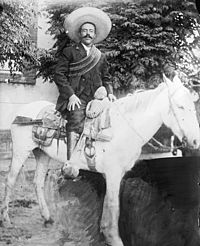 Pancho Villa | |
| Nickname(s) | Francisco Villa Pancho Villa El Centauro del Norte (The Centaur of the North) |
| Allegiance | Mexico (antireeleccionista revolutionary forces) |
| Rank | General |
| Commands | División del Norte |
| Battles / wars | Mexican Revolution |
José Doroteo Arango Arámbula (5 June 1878 – 20 July 1923), better known by his pseudonym Francisco Villa or its hypocorism Pancho Villa, was one of the most prominent Mexican Revolutionary generals.
As commander the División del Norte (Division of the North), he was the veritable caudillo of the Northern Mexican state of Chihuahua which, given its size, mineral wealth, and proximity to the United States of America, provided him with extensive resources. Villa was also provisional Governor of Chihuahua in 1913 and 1914. Although he was prevented from being accepted into the "panteón" of national heroes until some 20 years after his death, today his memory is honored by Mexicans, Americans, and many people around the world. In addition, numerous streets and neighborhoods in Mexico are named in his honor.
Villa and his supporters seized hacienda land for distribution to peasants and soldiers. He robbed and commandeered trains, and, like the other revolutionary generals, printed fiat money to pay for his cause. Villa's men and supporters became known as Villistas during the revolution from 1910 to roughly 1920.
Villa's dominance in northern Mexico was broken in 1915 through a series of defeats he suffered at Celaya and Agua Prieta at the hands of Álvaro Obregón and Plutarco Elías Calles. After Villa's famous raid on Columbus in 1916, the US Army General John J. Pershing tried unsuccessfully to capture Villa in a nine-month pursuit that ended when Gen. Pershing was called back as the United States entry into World War I was assured. Villa retired in 1920 and was given a large estate which he turned into a "military colony" for his former soldiers. In 1923, he decided to re-involve himself in Mexican politics and as a result was assassinated, most likely on the orders of Obregon.
Early life
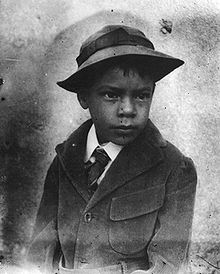
Villa was born as Doroteo Arango to poor peasants Agustín Arango and Micaela Arambula in the Rancho de la Coyotada,[1] one of the largest haciendas in the state of Durango. Doroteo was the oldest of five children and as such helped his mother care for his siblings after Agustín died.[2]
According to his own later statements, at the age of sixteen, Doroteo shot Lopez Negre, one of the owners or administrators of the hacienda, when Negre tried to rape Doroteo's sister. Some historians have questioned the veracity of this story however.[2] Subsequently he fled to the Durango hills where he became a part of a bandit band. Eventually he was a member of an outlaw "super group" headed by Ignacio Parra, one of the most famous bandits of Durango at the time.[2] It was then that he took the name "Francisco Villa" after his paternal grandfather, Jesus Villa.[2]
In 1902, Pancho Villa was arrested for stealing mules and assault. While he was spared the death sentence from the rurales due to his connections with the powerful Pablo Venezuela (to whom Villa would sell the stolen goods), he was forced to join the federal army. Several months later he deserted and fled to the neighboring state of Chihuahua.[2]
According to Frank McLynn, until 1910 Villa would alternate episodes of banditry with more legitimate pursuits.[2]
Beginnings of the Mexican Revolution
When one of Madero's military commanders, Pascual Orozco, started a counterrebellion against Madero, Villa gathered his mounted cavalry troops and fought alongside General Victoriano Huerta to support Madero. However, Huerta viewed Villa as an ambitious competitor, and later accused Villa of stealing a horse and insubordination; he then had Villa sentenced to execution in an attempt to dispose of him. Reportedly, Villa was standing in front of a firing squad waiting to be shot when a telegram from President Madero was received commuting his sentence to imprisonment, from which Villa later escaped. During Villa's imprisonment, Gildardo Magaña Cerda, a Zapatista who was in prison at the time, provided the chance meeting which would help to improve his poor reading and writing skills, which would serve him well in the future during his service as provisional governor of the state of Chihuahua.
Fight against Huerta's usurpation
In the second part of the Mexican Revolution, President Francisco I. Madero was betrayed and assassinated.[3] After crushing the Orozco rebellion, Victoriano Huerta, with the federal army he commanded, held the majority of military power in Mexico. Huerta saw an opportunity to make himself the dictator of Mexico, and he began to conspire with men such as Bernardo Reyes, Félix Díaz (nephew of Porfirio Díaz), and the American ambassador Henry Lane Wilson, which resulted in La decena trágica (the "Ten Tragic Days") and the assassination of President Madero.[4]
After Madero's murder, Huerta proclaimed himself provisional president. Venustiano Carranza then proclaimed the Plan of Guadalupe to oust Huerta as an unconstitutional usurper. The politicians and generals (who included Pablo González, Álvaro Obregón, Emiliano Zapata and Villa) who supported Carranza's plan were collectively styled the Ejército Constitucionalista de México (Constitutionalist Army of Mexico), the constitucionalista adjective was added to stress the point that Huerta had not obtained power through methods prescribed by Mexico's Constitution of 1857.

Villa's hatred of Huerta became more personal and intense after March 7, 1913, when Huerta ordered the murder of Villa's political mentor, Abraham González, who had worked with Madero and Villa since 1910. González had been one of Madero's political advisors. He recruited Francisco Villa in 1910 to support Madero with the Plan de San Luis which started the first part of the Mexican Revolution with the armed movement of 20 November 1910. The Plan de San Luis was conceived to force Dictator Porfirio Diaz (Mexican president for 33 years) to leave the presidency and allow for a Mexican democracy.[3] Villa later recovered González's remains and gave his friend a proper funeral in Chihuahua.
Villa joined the rebellion against Huerta, entering the valley of the Río Bravo del Norte (Rio Grande) into Ciudad Juárez initially with a mere 8 men, 2 pounds of coffee, 2 pounds of sugar, and 500 rounds of rifle ammunition. The new United States president, Woodrow Wilson, dismissed Ambassador Wilson, and began to support Carranza's cause. Villa's remarkable generalship and recruiting appeal, combined with ingenious fundraising methods to support his rebellion, were a key factor in forcing Huerta from office a little over a year later, on 15 July 1914.
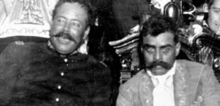
This was the time of Villa's greatest fame and success. He recruited soldiers and able subordinates (both Mexican and mercenary) such as Felipe Ángeles, Manuel Chao, Sam Dreben and Ivor Thord-Gray, and raised money using methods such as forced assessments on hostile hacienda owners, and train robberies. In one notable escapade, he held 122 bars of silver ingot from a train robbery (and a Wells Fargo employee) hostage and forced Wells Fargo to help him sell the bars for cash.[5] A rapid, hard-fought series of victories at Ciudad Juárez, Tierra Blanca, Chihuahua and Ojinaga followed. The well known North American journalist and fiction writer Ambrose Bierce, then in his seventies, accompanied Villa's army during this period and witnessed the battle of Tierra Blanca. Bierce vanished while still with Villa's army in or after December 1913. Oral accounts of his execution by firing squad were never verified.
Villa then became provisional governor of the state of Chihuahua. According to some of the references, Villa considered Tierra Blanca his most spectacular victory.[6] Villa's war tactics were studied by the United States Army and a contract with Hollywood was made. Hollywood would be allowed to film Villa's movements and 50% of the profit would be paid to Villa to support the Revolution.[3]

As governor of Chihuahua, Villa raised more money for a drive to the south by printing his own currency. He decreed his paper money to be traded and accepted at par with gold Mexican pesos, then forced the wealthy to give forced loans that would allow to pay salaries to the army as well as food and clothes. He also took some of the land owned by the hacendados (owners of the haciendas) to give it to the widows and family of dead revolutionaries. The forced loans would also support the war machinery of the Mexican Revolution.[3] He also confiscated gold from specific banks, in the case of the Banco Minero, by holding hostage a member of the bank's owning family, the extremely wealthy Terrazas clan, until the location of the bank's hidden gold was revealed.
Villa's political stature at that time was so high that banks in El Paso, Texas, accepted his paper pesos at face value. His generalship drew enough admiration from the U.S. military that he and Álvaro Obregón were invited to Fort Bliss to meet Brigadier General John J. Pershing.
The new pile of money was used to purchase draft animals, cavalry horses, arms, ammunition, mobile hospital facilities (railroad cars and horse ambulances staffed with Mexican and foreign volunteer doctors, known as Servicio sanitario), and food, as well as to rebuild the railroad south of Chihuahua City. The rebuilt railroad transported Villa's troops and artillery south, where he defeated Federal forces at Gómez Palacio, Torreón, and Zacatecas.[7]
Carranza tries to halt the Villa advance, the fall of Zacatecas

After Torreón, Carranza issued a puzzling order for Villa to break off action south of Torreón and instead ordered him to divert to attack Saltillo, and threatened to cut off Villa's coal supply if he did not comply. Coal was needed for railroad locomotives to pull trains transporting soldiers and supplies. This was widely seen as an attempt by Carranza to divert Villa from a direct assault on Mexico City, so as to allow Carranza's forces under Álvaro Obregón, driving in from the west via Guadalajara, to take the capital first, and Obregón and Carranza did enter Mexico City ahead of Villa. This was an expensive and disruptive diversion for the División del Norte, since Villa's enlisted men were paid the then enormous sum of a peso per day, and each day of delay cost thousands of pesos. Villa did attack Saltillo as ordered, winning that battle.
Villa, disgusted by what he saw as egoism, tendered his resignation. Felipe Ángeles and Villa's officer staff argued for Villa to withdraw his resignation, defy Carranza's orders, and proceed to attack Zacatecas, a strategic mountainous city considered nearly impregnable. Zacatecas was the source of much of Mexico's silver, and thus a supply of funds for whoever held it. Victory in Zacatecas would mean that Huerta's chances of holding the remainder of the country would be slim. Villa accepted Ángeles's advice, cancelled his resignation, and the División del Norte defeated the Federals in the Toma de Zacatecas (Taking of Zacatecas), the single bloodiest battle of the Revolution, with the military forces counting approximately 7,000 dead and 5,000 wounded, and unknown numbers of civilian casualties. (A memorial to and museum of the Toma de Zacatecas is on the Cerro de la Bufa, one of the key defense points in the battle of Zacatecas. Tourists use a teleférico (aerial tramway) to reach it, owing to the steep approaches. From the top, tourists may appreciate the difficulties Villa's troops had trying to dislodge Federal troops from the peak.) The loss of Zacatecas in June 1914 broke the back of the Huerta regime, and Huerta left for exile on 14 July 1914.
The revolutionary caudillos convened a National Convention, and conducted a series of meetings in Aguascalientes. This National Convention set rules for Mexico's path towards democracy. None of the armed revolutionaries were allowed to be nominated for government positions. They chose an interim president, Eulalio Gutierrez. Emiliano Zapata and Pancho Villa met at the convention. Zapata told Villa he feared Carranza's intentions were those of a dictator and not of a democratic president. True to Zapata's prediction, Carranza decided to oppose the agreements of the National Convention, setting off a civil war.[3]
Split with the United States and the Punitive Expedition

After years of public and documented support for Villa's fight, the United States, following the diplomatic policies of Woodrow Wilson, who believed that supporting Carranza was the best way to expedite establishment of a stable Mexican government, refused to allow more arms to be supplied to Villa's army, and allowed Carranza's troops to be relocated over U.S. railroads. Villa felt betrayed by the Americans. He was further enraged by Obregón's use of searchlights, powered by American electricity, to help repel a Villista night attack on the border town of Agua Prieta, Sonora, on 1 November 1915. In January 1916, a group of Villistas attacked a train on the Mexico North Western Railway, near Santa Isabel, Chihuahua, and killed several American employees of the ASARCO company. Passengers included 18 Americans, including 15 who worked for American Smelting and Refining Company. There was only one survivor, who gave the details to the press. Villa admitted to ordering the attack, but denied that he had authorized the shedding of American blood.[8]
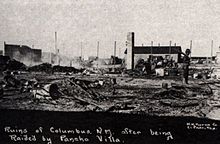
Cross-border attack on New Mexico
On 9 March 1916, General Villa ordered nearly 500 Mexican members of his revolutionary group to make a cross-border attack against Columbus, New Mexico. The raid was conducted because of the U.S. government's official recognition of the Carranza regime and for the loss of lives in battle due to defective bullets purchased from the United States.[9] They attacked a detachment of the 13th Cavalry Regiment (United States), seizing 100 horses and mules, and setting part of the town on fire. 18 Americans and about 80 Villistas were killed.[10] On 15 May, they attacked Glen Springs, Texas, killing a civilian and wounding three American soldiers; on 15 June, bandits killed four soldiers at San Ygnacio, Texas; on 31 July, one American soldier and a U.S. customs inspector were killed.[11]
Villa's battles and military actions
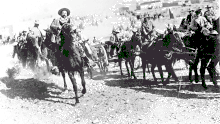
- First Battle of Ciudad Juárez (1911 won)
- Second Battle of Ciudad Juarez (1913 won)
- Battle of Tierra Blanca (1913 won)
- Battle of Chihuahua (1913 won)
- Battle of Ojinaga (1913 won)[12]
- First Battle of Torreón (1914 won)
- Battle of Gómez Palacio (1914 won)
- Battle of Saltillo (1914 won)
- Battle of Zacatecas (1914 won)
- Siege of Nogales (1915 lost)
- Battle of Celaya (1915 lost)
- Battle of Agua Prieta (1915 lost)
- Battle of Columbus (1916 lost)
German involvement in Villa's later campaigns
Before the Villa-Carranza irregular forces had left to the mountains in 1915, there is no credible evidence that Villa co-operated with or accepted any help from the German government or agents. Villa was supplied arms from the USA, employed international (Americans included) mercenaries and doctors, was portrayed as a hero in the US media, made business arrangements with Hollywood, and did not object to the 1914 US naval occupation of Veracruz. Villa's observation was that the occupation merely hurt Huerta. Villa opposed the armed participation of the United States in Mexico, but he did not act against the Veracruz occupation in order to maintain the connections in the United States necessary to buy bullets and other supplies. The German consul in Torreón did make entreaties to Villa, offering him arms and money to occupy the port and oil fields of Tampico to enable German ships to dock there, but the offer was rejected by Villa.
German agents did attempt to interfere, unsuccessfully, in the Mexican Revolution. Germans attempted to plot with Victoriano Huerta to assist him to retake the country, and in the infamous Zimmermann Telegram to the Mexican government, proposed an alliance with the government of Venustiano Carranza.
There were documented contacts between Villa and the Germans, after Villa's split with the Constitutionalists. Principally this was in the person of Felix A. Sommerfeld (noted in Katz's book), who allegedly, in 1915, funneled $340,000 of German money to the Western Cartridge Company to purchase ammunition. However, the actions of Sommerfeld indicate he was likely acting in his own self-interest (he acted as a double agent for Carranza). Villa's actions were hardly that of a German catspaw; rather, it appears that Villa only resorted to German assistance after other sources of money and arms were cut off.[13]
At the time of Villa's attack on Columbus, New Mexico in 1916, Villa's military power had been marginalized (he was repulsed at Columbus by a small cavalry detachment, albeit after doing a lot of damage), his theater of operations was mainly limited to western Chihuahua, he was persona non grata with Mexico's ruling Carranza constitutionalists, and the subject of an embargo by the United States; so communication or further shipments of arms between the Germans and Villa would have been difficult.
A plausible explanation of any Villa-German contacts after 1915 would be that they were a futile extension of increasingly desperate German diplomatic efforts and Villista pipe dreams of victory as progress of their respective wars bogged down. Villa effectively did not have anything useful to offer in exchange for German help at that point.
When weighing claims of Villa conspiring with Germans, one should take into account that at the time, portraying Villa as a German sympathizer served the propaganda ends of both Carranza and Wilson.
The use of Mauser rifles and carbines by Villa's forces does not necessarily indicate any German connection. These weapons were widely used by all parties in the Mexican Revolution, Mauser longarms being enormously popular. They were standard issue in the Mexican Army, which had begun adopting 7 mm Mauser system arms as early as 1895.[14]
Last years, death and gravesite

After the revolution ended in 1920, Villa was given an hacienda outside of Hidalgo del Parral, Chihuahua by the national government. This was in addition to the Quinta Luz estate that he owned with his wife, María Luz Corral de Villa, in Chihuahua, Chihuahua.
On Friday, July 20, 1923, Villa was killed while visiting Parral. Usually accompanied by his entourage of Dorados (his bodyguards) Pancho Villa frequently made trips from his ranch to Parral for banking and other errands. This day, however, Villa had gone into the town without them, taking only a few associates with him. He went to pick up a consignment of gold from the local bank with which to pay his Canutillo ranch staff. While driving back through the city in his black 1919 Dodge roadster someone shouted Viva Villa! - a signal for a group of seven riflemen who then appeared in the middle of the road and fired over 40 shots into the automobile.[15] In the fusillade of shots, Villa was hit by nine dumdum bullets in his head and upper chest, killing him instantly.[16] He was found in the driver seat of the car, with one hand reaching for his gun.[15] One of Villa's bodyguards, Ramon Contreras, managed to kill at least one of the assassins before he himself managed to escape. Two other bodyguards who were with him also died, as did his assistant.[15] He is reported to have died saying "Don't let it end like this. Tell them, I said something".
While it has never been completely proven who was responsible for the assassination,[17] most historians attribute Villa's death to a well planned conspiracy, most likely initiated by Plutarco Elías Calles and Joaquin Amaro with at least tacit approval of the then president of Mexico, Obregon.[15] At the time, a state legislator from Durango, Jesus Salas Barraza, claimed sole responsibility for the plot. Obregon had him arrested and sentenced to a long prison term but then pardoned him three months later. In a letter to the governor of Durango, Jesus Castro, Barraza agreed to be the "fall guy" and the same arrangement is mentioned in letters exchanged between Castro and Amaro. Others involved in the conspiracy were Felix Lara, the commander of federal troops in Parral, who was paid 50,000 pesos by Calles to remove his soldiers and policemen from the town on the day of the assassination, and Meliton Lozoya, the former owner of Villa's hacienda whom Villa was demanding pay back funds he had embezzled. It was Lozoya who planned the details of the assassination and found the men who carried it out.[15]
Villa's purported death mask was hidden at the Radford School in El Paso, Texas, until the 1970s, when it was sent to the Historical Museum of the Mexican Revolution in Chihuahua; other museums have ceramic and bronze representations that do not match this mask.[18]
Villa was buried in the city cemetery of Parral, Chihuahua,[19][20] Tombs for Villa exist in Chihuahua and Mexico City place.
Period newsreel showing views of the assassination location in Hidalgo del Parral, Chihuahua, news reporters at the scene, and Villa's bullet riddled corpse and auto still exist to this day. Villa's skull was stolen from his grave in 1926.[21]
Villa's last living son, Ernesto Nava, died in Castro Valley, California, at the age of 94, on December 31, 2009.[22] Nava appeared yearly in festival events in his hometown of Durango, Mexico, enjoying celebrity status until he became too weak to attend.
In films, video, and television

Villa appeared as himself in films in 1912, 1913, 1914 and 1916:
- Life of Villa (1912)
- With General Pancho Villa in Mexico (1913, unconfirmed)
- The Life of General Villa (1914)
- Following the Flag in Mexico (1916)
The 1934 biopic Viva Villa! was nominated for an Academy Award for Best Picture. Actors that have portrayed Villa include:
- Raoul Walsh (1912, 1914) The Life of General Villa
- Wallace Beery (1917) Patria
- George Humbert (1918) Why America Will Win
- Wallace Beery (1934) Viva Villa!, with Phillip Cooper (Pancho Villa as a boy)
- Juan F. Triana (1935) El Tesoro de Pancho Villa
- Domingo Soler (1936) ¡Vámonos con Pancho Villa!
- Maurice Black (1937) Under Strange Flags
- Leo Carrillo (1949) Pancho Villa Returns
- Pedro Armendáriz (1950, 1957, 1960 twice)
- Alan Reed (1952) Viva Zapata!
- Victor Alcocer (1955) El siete leguas
- Rodolfo Hoyos, Jr. (1958) Villa!!
- Rafael Campos (1959) Have Gun Will Travel, Season 3-Episode 6 (Pancho)
- José Elías Moreno (1967) El Centauro Pancho Villa
- Ricardo Palacios (1967) Los Siete de Pancho Villa
- Yul Brynner (1968) Villa Rides
- Telly Savalas (1971) Pancho Villa!
- Heraclio Zepeda (1973) Reed, México insurgente
- Antonio Aguilar (1974) La Muerte de Pancho Villa
- Héctor Elizondo (1976) Wanted: The Sundance Woman (TV)
- Freddy Fender (1977) She Came to the Valley
- José Villamor (1980) Viva México (TV)
- Jorge Reynoso (1982) Red Bells: Mexico in Flames
- Gaithor Brownne (1985) Blood Church
- Guillermo Gil (1987) Senda de Gloria (TV series)
- Pedro Armendáriz, Jr. (1989) Old Gringo
- Mike Moroff (1992) The Young Indiana Jones Chronicles, Young Indiana Jones and the Curse of the Jackal, "Mexico, March 1916", The Adventures of Young Indiana Jones: Spring Break Adventure
- Antonio Aguilar (1993) La sangre de un valiente
- Alonso Echánove (1993) By Our Own Correspondent
- Jesús Ochoa (1995) Entre Pancho Villa y una mujer desnuda
- Carlos Roberto Majul (1999) Ah! Silenciosa
- Peter Butler (2000) From Dusk Till Dawn 3: The Hangman's Daughter
- Antonio Banderas (2003) And Starring Pancho Villa as Himself
- Alejandro Calva (2009) Chico Grande
- Johnny Depp (2012) Wild Roses, Tender Roses, based on the novel The Friends of Pancho Villa, by James Carlos Blake
In popular culture

- The Friends of Pancho Villa, a 1996 novel by James Carlos Blake
- Mexico City subway (Metro) station Metro División del Norte is named after Pancho Villa's command, and its logo depicts him riding a horse
- The French musical group Magazine 60 published a song titled "Pancho Villa" in 1987.
- Serge Gainsbourg recorded in 1961 the tribute song "Viva Villa" for his album "L'étonnant Serge Gainsbourg".
- Víctor Jara in his album Canto Libre in 1970 published the song "Corrido de Pancho Villa".
- Kid Frost has published a song called "Pancho Villa" featuring Mellow Man Ace.
- The country music singer Steve Earle published a song titled "Mercenary Song" in his 1995 album "Train A Comin'" (ASIN B000002NAV) about two men from Georgia who go to Mexico to join Pancho Villa's army.
- In the pilot episode of the 1992-96 TV series The Young Indiana Jones Chronicles, the title character briefly becomes involved with Pancho Villa and the Mexican Revolution, which is referenced in the 2008 movie Indiana Jones and the Kingdom of the Crystal Skull.
- The Northern Irish poet Paul Muldoon's collection, "Mules" (1977) begins with the poem "Lunch With Pancho Villa".
- Pancho Villa was portrayed as a teenage rebel in an October 1959 episode of the TV series Have Gun, Will Travel. That was an anachronism, since this series took place in the years about 1877 - one year before Villa's birth.
- The extreme metal band Brujeria recorded a song called Pancho Villa as a homage.
- "Pancho and Lefty", a song written by the singer-songwriter Townes Van Zandt is often associated with Pancho Villa (although the song does not deal with Pancho Villa)
- "Tonight We Ride" is a song by Paul Eason that talks about Villa's actions during the Mexican Revolution.
- "Pancho Villa" is the title of a song by Rich O'Toole.
- In Harry Turtledove's Great War trilogy, Doroteo Arango is a Presidential candidate for the 1915 Confederate Presidential election (as Mexican states Chihuahua and Sonora are Confederate states in this series).
See also
{{{inline}}}
Further reading
- Paco Ignacio Taibo II, "Pancho Villa: Una Biografia Narrativa", Planeta (August 30, 2006). ISBN 9703703348, ISBN 978-9703703340.
- Paco Ignacio Taibo II, "Pancho Villa", History Channel Documentary, 2008.
- Guadalupe Villa y Rosa Helia Villa (eds.), Retrato autobiográfico, 1894-1914, Mexico City, Mexico: Universidad Nacional Autónoma de México: Taurus: Santillana Ediciones Generales, c2003 (2004 printing). ISBN 968-19-1311-6.
- Katz, Friedrich. Life and Times of Pancho Villa, Stanford University Press, 1998, ISBN 0-8047-3046-6.
- Pancho Villa Page http://www.ojinaga.com/villa/.
- Eric J. Hobsbawm, Bandits 1969, New Pr. 2000. ISBN 1565846192 resp. ISBN 978-1565846197.
- Jeff Howell, Pancho Villa, Outlaw, Hero, Patriot, Cutthroat: Evaluating the Many Faces of Historical Text Archive.
- Taylor, Joseph Rogers (1914). ""Pancho" Villa At First Hand: Personal Impressions Of The Most Picturesque And Most Successful Soldier That Mexico Has Produced In Recent Years". The World's Work: A History of Our Time. XLIV (2). Doubleday, Page & Co.: 265–284. Retrieved 2009-08-04.
{{cite journal}}: Cite has empty unknown parameter:|coauthors=(help); Unknown parameter|month=ignored (help) - Micro-biographies, Figures in Mexican History. Francisco Villa, México, 1993. http://www.elbalero.gob.mx/kids/history/html/rev/biovilla.html, 1993.
References
- ^ Katz, Friedrich. The Life and Times of Pancho Villa, Stanford University Press, 1998, p. 64
- ^ a b c d e f Frank McLynn, "Villa and Zapata", Basic Books, 2000, pg. 58
- ^ a b c d e Paco Ignacio Taibo II, "Pancho Villa: Una Biografia Narrativa", Planeta (August 30, 2006).
- ^ Usurper: The Dark Shadow of Victoriano Huerta by Jim Tuck ©1999.
- ^ Burress, Charles (5 May 1999). "Wells Fargo's Hush-Hush Deal With Pancho Villa". San Francisco Chronicle.
- ^ Eisenhower, John S. D. Intervention: The United States and the Mexican Revolution, 1913-1917 (New York: W. W. Norton, 1993) p. 58
- ^ Map of Constitutionalist Army Battles
- ^ http://www.utb.edu
- ^ Huachuca Illustrated, vol 1, 1993: Villa's Raid on Columbus! New Mexico
- ^ "Buffalo Soldiers at Huachuca: Villa's Raid on Columbus, New Mexico". Huachuca Illustrated. 1. 1993. Retrieved 2009-01-12.
- ^ http://www.archives.gov/publications/prologue/1997/winter/mexican-punitive-expedition-2.html
- ^ The Battle of Ojinaga
- ^ Pancho Villa as a German Agent?
- ^ Mexican Secretary Of Defense - Armies of the Revolution
- ^ a b c d e Frank McLynn, "Villa and Zapata", Basic Books, 2000, pg. 393
- ^ Katz, Friedrich. The Life and Times of Pancho Villa, Stanford University Press, 1998, p. 766
- ^ http://www.hsgng.org/pages/pancho.htm
- ^ Questions Begin to Arise Over Death Mask of Pancho Villa.
- ^ Katz, Friedrich. The Life and Times of Pancho Villa, Stanford University Press, 1998, p. 767
- ^ Pancho Villa (1878 - 1923) - Find A Grave Memorial.
- ^ Manuel Plana, "Pancho Villa and the Mexican Revolution", Interlink Illustrated Histories, 2002, pg. 117
- ^ Kurhi, Eric. Last son of Pancho Villa dies in Hayward. The Oakland Tribune. Posted: 01/08/2010
External links
- Statue of Pancho Villa, the Mexican Revolutionary Leader in Tucson, Arizona, United States
- Encyclopædia Britannica, Pancho Villa
- Photos of Villa and the Mexican Revolution - some graphic images, and some also in the book The Wind That Swept Mexico.
- Camp Furlong and Columbus, New Mexico - 1916
- Documentary about Pancho Villa
- People of the Mexican Revolution
- 19th-century Mexican people
- Folk saints
- Governors of Chihuahua
- Mexican generals
- Mexican rebels
- Mexican outlaws
- People from Durango
- Deaths by firearm in Mexico
- 1878 births
- 1923 deaths
- Mexican people of Basque descent
- Mexican revolutionaries
- People murdered in Mexico
- Mexican folklore
- Unsolved murders in Mexico
- Mexican guerrillas
